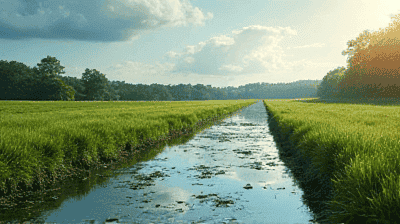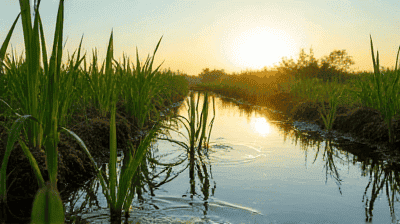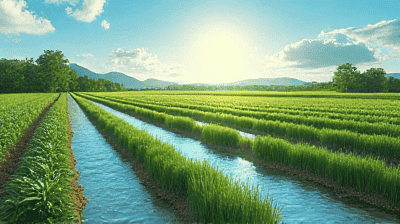
Agricultural runoff is a significant contributor to water pollution, posing serious threats to the health of our waterways, ecosystems, and communities. As rainwater and melting snow wash over agricultural fields, they can carry fertilizers, pesticides, and sediment into nearby rivers, lakes, and oceans. This pollution not only harms aquatic life but can also adversely affect drinking water supplies and human health.
Agricultural runoff occurs when rainwater or irrigation water flows over agricultural fields and picks up contaminants like nutrients (nitrogen and phosphorus), pesticides, herbicides, and sediments before entering nearby waterways. This runoff can lead to nutrient pollution, sedimentation, and the introduction of harmful chemicals into aquatic ecosystems.
Eutrophication: Excess nutrients from fertilizers can trigger harmful algal blooms in water bodies. These blooms deplete oxygen levels in the water, leading to dead zones where aquatic life cannot survive.
Sedimentation: Sediment from fields can cloud waterways, disrupting photosynthesis and smothering aquatic habitats.
Chemical Contamination: Pesticides and herbicides can accumulate in the water, posing risks to human health and wildlife.
Drinking Water Supply Risks: Polluted runoff can compromise drinking water sources, leading to increased treatment costs and public health concerns.
Addressing agricultural runoff is critical for sustaining agriculture, protecting water quality, and ensuring the health of ecosystems. Innovative solutions that combine technology, sustainable practices, and community engagement are needed to tackle this pressing issue.

Precision agriculture involves using technology to optimize farming practices, ensuring that inputs like water, fertilizers, and pesticides are applied efficiently and effectively. This approach uses data and analytics to make real-time decisions that enhance crop yields while minimizing environmental impacts.
Targeted Input Application: By using sensors, drones, and GPS technology, farmers can apply fertilizers and pesticides only where needed and in the correct amounts. This targeted approach reduces the likelihood of excess chemicals washing into water bodies.
Soil Moisture Monitoring: Precision agriculture techniques can monitor soil moisture levels, allowing farmers to irrigate more efficiently. Reducing water runoff not only conserves water but also minimizes the amount of chemicals transported during rain events.
Crop Health Monitoring: Drones equipped with multispectral cameras can assess crop health, identifying areas that need attention without overapplying treatments. This data-driven strategy reduces the use of fertilizers and pesticides and ultimately decreases runoff.
While precision agriculture offers numerous benefits, challenges exist in terms of cost and technology adoption, particularly for small-scale farmers. Support from agricultural organizations, research institutions, and government programs can help facilitate the adoption of these innovative practices.
Buffer strips are vegetated areas situated between agricultural fields and waterways. Riparian zones refer to the interface between land and water, consisting of vegetation that stabilizes banks and filters runoff. These natural systems serve as protective barriers that can significantly reduce agricultural runoff.
Filtering Effluent: Vegetation in buffer strips and riparian zones captures sediment, nutrients, and other pollutants from runoff before they reach waterways. The roots of plants absorb excess nutrients, while soil microorganisms break down contaminants.
Reducing Erosion: The presence of vegetation stabilizes soil, reducing erosion caused by water flow. This helps decrease the amount of sediment entering adjacent waterways.
Enhancing Biodiversity: Buffer zones promote biodiversity by providing habitat for various plant and animal species, contributing to healthier ecosystems overall.
To optimize their effectiveness, buffer strips and riparian zones should be designed with the following considerations:
Width: Wider buffer zones are more effective at filtering pollutants and providing habitat. Buffer strips should ideally be at least 30 feet wide, depending on site conditions.
Vegetation Type: Native plants should be prioritized, as they are adapted to local soil and climate conditions, require less maintenance, and support native wildlife.
Continuous Maintenance: Regular maintenance, including monitoring for invasive species and allowing natural growth, will maximize the ecological functions of these systems.

Cover cropping involves planting specific crops in the off-season to protect and enrich the soil, while crop rotation is the practice of alternating different crops in the same field across seasons. Both methods are essential practices in sustainable agriculture that can reduce runoff.
Soil Health Improvement: Cover crops enhance soil structure, improve moisture retention, and increase organic matter, leading to healthier soil that can capture water more effectively. Healthier soils are less prone to erosion and runoff.
Nutrient Absorption: Cover crops can absorb excess nutrients from the soil, preventing them from leaching into waterways. Certain cover crops, such as legumes, can also fix atmospheric nitrogen, enriching the soil without chemical fertilizers.
Pest and Weed Suppression: Crop rotation disrupts pest and disease cycles while reducing weed pressure, decreasing the reliance on chemical pesticides and herbicides.
To maximize the benefits of cover cropping and crop rotation, farmers should:
Choose Suitable Species: Select cover crops that suit local climate and soil conditions, as well as those that can provide specific benefits such as nitrogen fixation or erosion control.
Integrate into Existing Practices: Farmers can seamlessly incorporate these practices into their existing crop management strategies without significant disruption.
Access Resources: Utilizing resources from local agricultural extension services, conservation organizations, and farmer networks can help growers learn about effective cover cropping and crop rotation strategies.
Fertilizers are essential for agricultural productivity, but improper use can lead to excessive runoff and water pollution. Adopting water-quality-friendly fertilization practices can help mitigate these risks.
Soil Testing: Farmers should perform regular soil tests to determine nutrient levels and deficiencies. This information allows for precise application of fertilizers, reducing the risk of over-application and subsequent runoff.
Timing and Method of Application: The timing of fertilizer application should align with crop growth cycles, especially before rain events. Methods such as banding or using nitrification inhibitors can reduce nutrient losses to the environment.
Integrated Nutrient Management: Combining organic and synthetic fertilizers can optimize nutrient availability while minimizing the risk of runoff. Cover crops can also provide a source of organic nutrients and reduce chemical dependency.
Farmers can benefit from attending workshops and training sessions offered by agricultural organizations to enhance their knowledge of environmentally friendly fertilization practices. Access to government programs that provide financial incentives for implementing best management practices is also essential.

Advancements in technology and data analytics are revolutionizing agricultural practices, offering innovative tools to address runoff issues effectively.
Remote Sensing and Drones: These technologies allow farmers to gather valuable data on soil health, crop conditions, and moisture levels. With this information, they can make informed decisions about irrigation and fertilizer application, mitigating runoff risks.
Data Analytics Platforms: Platforms that integrate weather data, soil moisture metrics, and farm management systems provide farmers with actionable insights to optimize their practices. This information can help farmers schedule activities to reduce runoff impact.
Mobile Apps: Agricultural mobile applications can serve as powerful tools for farmers. These apps can provide real-time information about weather patterns, soil conditions, and best practices.
To ensure that these technologies are accessible to all farmers, it is vital to address barriers such as costs, access to training, and technological literacy. Governments, agricultural organizations, and technology developers can collaborate to provide subsidies, grants, and training programs to facilitate adoption.
Agricultural runoff is a critical environmental issue that requires a multifaceted approach. By implementing innovative solutions such as precision agriculture, buffer strips, cover cropping, improved fertilization practices, and advanced technology, we can significantly reduce the impact of agricultural runoff on waterways.
These strategies not only protect water quality and ecosystems but also contribute to sustainable agricultural practices that support farmers and local communities. Collaboration among farmers, policymakers, environmental organizations, and consumers is essential to foster a collective commitment to water stewardship and environmental responsibility.
As we continue to explore and adopt these innovative solutions, we pave the way for a cleaner, healthier future for our waters, ecosystems, and agricultural systems.